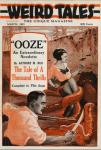AustLit
Latest Issues
AbstractHistoryArchive Description
A popular American pulp-fiction magazine, Weird Tales
published the work of many important science-fiction, fantasy, and
horror writers, among them a number of Australians. It's history is a
convoluted one, however, being published by a number of different
companies and in a variety of different forms. Founded in 1923 by J. C.
Henneberger and J. M. Lansinger (Rural Publishing) ran into financial
problems after only thirteen issues and closed down for several months
before being revived by Henneberger under the auspices of a new company -
the Popular Fiction Publishing Co. Under the editorship of Farnsworth
Wright the magazine survived the great depression, flourishing under
the same company until being sold to William J. Delaney in 1938.
Between 1938 and its second closure in September 1954 the magazine was published by Weird Tales Inc, a subsidiary of Short Stories Inc. During those 16 years, however, it managed only marginal success. Although the only regular magazine outlet for supernatural fiction its publisher pulled out of the business. The rights to the magazine were eventually acquired by Leo Margulies (Renown Publishing) who revived it in 1973.Only four pulp-sized issues were published by Margulies and editor Sam Mosowitz prior to the death of the Margulies in 1975. The rights to Weird Tales were bought by Robert E. Weinberg from Margulies's widow, and he eventually formed Weird Tales Limited to protect and license the name.
The fifth Weird Tales incarnation was published as paperback quarterly by Kensington Publishing (possibly though its Zebra imprint). Under editor by Lin Carter, who leased the rights from Weinberg, four issues were published (1981-1984) before it too was closed down. Weinberg then licensed the Weird Tales name to the Bellerophon Network, a publishing company owned by Brian Forbes. The magazine was poorly funded and distributed, however, and failed after only 2 issues.
The next company to publish Weird Tales was the Terminus Publishing Co of Pennsylvania, which acquired the rights in 1985. The initial editors were George
H. Scithers, Darrell Schweitzer and John Gregory Betancourt. In 1994, four years after Betancourt left to focus on his newly established company Wildside Press, Weinberg refused to renew the licence with Terminus. This forced the company to published a retitled magazine, Worlds of Fantasy and Horror (with the numbering reverting back to Volume 1, No 1). After four issues the magazine lapsed, and it was not until 1998 that Scithers (by then the sole publisher) merged the magazine with publisher Warren Lapine (DNA Publications). Through Lapine's influence the licence was renewed and Weird Tales was revived in the summer of 1998 with issue #313. The new numbering system incorporated the four Worlds of Fantasy and Horror issues.
With Lapine as publisher and Scithers and Schweitzer as editors the magazine continued through until acquired by John Betancourt's Wildside Press in 2005. Bettancourt on-sold the magazine in 2012 to Nth Dimension Media, a New York City-based company owned by Marvin Kaye and John Harlacher.
Notes
-
Further Reference:
- Mike Ashley, 'Weird Tales.' The Encyclopedia of Fantasy. Eds. John Clute and John Grant. (1997).
- Weinberg, Robert. The Weird Tales Story (1977).
- 'Weird Tales.' Encyclopedia of Science Fiction. (sighted 26/02/2013).
- 'Weird Tales.' Wikipedia. (sighted 26/02/2012)
- Mike Ashley, 'Weird Tales.' The Encyclopedia of Fantasy. Eds. John Clute and John Grant. (1997).
Publication Details of Only Known VersionEarliest 2 Known Versions of
Works about this Work
-
The Curious Case of Roger Dard : Fandom, Censorship and Sex in the 1950s and 60s
2006
single work
essay
— Appears in: Steam Engine Time , September no. 5 2006; (p. 24-29) James Doig and Milan Smiljkovic discuss the adverse impact on the growth of science fiction in Australia of the Customs (Literature Censorship) Regulations 1937, and the Literature Censorship Board created under the regulations. Of special concern were the provisions that prohibited the importation of books and magazines that placed 'undue emphasis on horror' or which 'encouraged depravity'. A campaign in the early 1950s to overturn these provisions was led by Perth-based Roger Dard, an active member of fantasy fandom in Australia and overseas during the 1940s and 1950s. -
But Not Ours, Alas
2001
single work
review
— Appears in: Notes on Australian Science Fiction 2001; (p. 152-153)
— Review of Weird Tales 1923-1924 periodical (23 issues) Discusses the influence of the the USA science fiction periodical, Weird Tales, q.v.
-
But Not Ours, Alas
2001
single work
review
— Appears in: Notes on Australian Science Fiction 2001; (p. 152-153)
— Review of Weird Tales 1923-1924 periodical (23 issues) Discusses the influence of the the USA science fiction periodical, Weird Tales, q.v. -
The Curious Case of Roger Dard : Fandom, Censorship and Sex in the 1950s and 60s
2006
single work
essay
— Appears in: Steam Engine Time , September no. 5 2006; (p. 24-29) James Doig and Milan Smiljkovic discuss the adverse impact on the growth of science fiction in Australia of the Customs (Literature Censorship) Regulations 1937, and the Literature Censorship Board created under the regulations. Of special concern were the provisions that prohibited the importation of books and magazines that placed 'undue emphasis on horror' or which 'encouraged depravity'. A campaign in the early 1950s to overturn these provisions was led by Perth-based Roger Dard, an active member of fantasy fandom in Australia and overseas during the 1940s and 1950s.




